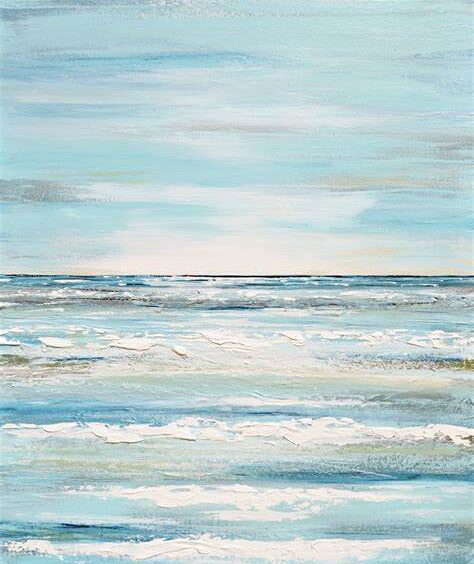Behind the Scenes of Creating Ocean-Inspired Masterpieces

The ocean’s endless beauty and mysteries have lured artists for centuries to try capturing its alluring essence. The vibrant colors of coral reefs, the alien elegance of jellyfish, the perpetual drama of stormy waves – the marine world brims with creative possibilities.
Translating the sea’s splendor and emotion into art poses unique challenges but delivers excellent rewards. Emerging techniques allow for expanding the oceanic palette while innovation continues to push artistic boundaries. More than pretty pictures, Ocean inspired art ideas also promotes conservation by fostering connections. Ultimately, the ocean dares artists to plunge into her creative depths.
Overview of Ocean-Inspired Art
Throughout history and across cultures, creatives have felt drawn to interpreting the ocean’s visual magnificence. Early mosaics, maps, ceramics and more hint at our abiding fascination with the alien marine landscape. Master painters like Homer, Monet and Turner sought to distil the sea’s essence into iconic works still revered today. Sculptors, photographers, installation artists and others also respond to the siren call of the deep blue sea.
The sea symbolizes emotion itself – anger, danger, romance, isolation. Yet it also represents the ultimate freedom, unable to be contained. This rich set of meanings and associations entices artists to employ marine motifs.
The Vastness of Inspiration from Marine life and Seascapes
Life teems below the surface in a stranger-than-fiction catalog of creatures like luminous jellyfish, camouflaged octopuses and grand sea turtles. Muscular waves build into foamy peaks before crashing into rocky cliffs. Sun rays pierce through the water, scattering into shattered abstract designs along the sandy bottom.
Seascapes also drive creativity—lonely lighthouses standing sentinel above the clouds. Fog rolling across glassy waters hiding mysteries. Coral reefs shimmering just below turquoise shallows. Each seaborne vista tells a story artists long to translate into expressive works.
Historical Context of Artists Drawn to the Sea’s Beauty
Evidence of aquatic life appears in some of humanity’s first artistic attempts. Ancient Indonesian cave paintings dating back 40,000 years capture primitive fishing scenes. Mosaics, pottery, graffiti and more point to an enduring attraction with the marine world. Tales like 20,000 Leagues Under the Sea and Moby Dick also speak to our endless intrigue.
Masters like Homer breathlessly depicted the sea’s terrible beauty in stirring scenes braving stormy waters. Japanese ukiyo-e artists like Hokusai concocted dreamlike visions of diving women. Later iconoclasts like surrealist Dali inserted melting clocks into otherworldly shorelines to simulate the timelessness of the tide’s ebb and flow.
Inspiration Sources
Marine life and ecosystems
The mysterious fathoms offer boundless inspiration. Psychedelic coral reefs attract legions of aquatic locals from angelfish to anemones. Playful pods of dolphins and whales dance just under the surface. Gloriously bizarre creatures like sea stars and nudibranchs practically defy belief with their alien elegance.
Coral Reefs and their Vibrant Colors
Corals lie at the heart of the ocean’s vivid color palette. Branching corals glow in neon hues, sheltering tiny anemones in phosphorescent bases. Brain and moose corals take uncanny shapes in unlikely fluorescent shades. Even coral bleaching offers aesthetic anguish, representing human impact on fragile underwater havens.
Sea Creatures such as Whales, Dolphins, Jellyfish, Octopuses
The ocean teems with inspiration, showcasing evolutionary whimsy. Octopuses offer eight appendages to incorporate while color-changing skins hint at camouflage mysteries creatively. Jellyfish make diaphanous yet dangerous inspirations glowing in the shallows. Mighty whales and shimmering sharks make majestic subjects for capturing grand sea stories.
Seascape Elements
Just as captivating are the ocean’s moody persona and mesmerizing environments for creatives to interpret.
Waves, Tides, and Currents
Foamy waves hold shape-shifting possibilities as relentless cycles of tides march to lunar rhythms. Dark rip currents tear through calm turquoise waters, hinting at hidden dangers. Capturing even one aspect of fluid dynamics tests an artist’s abilities.
Sunlight Filters through Water, Creating Unique Hues.
Photographers, mainly, chase ephemeral moments as golden rays pierce undulating surfaces. Underwater light diffusion creates variegated impressionistic patterns on the sea floor, allowing for artistic reinterpretation—these dance floors of the fair offer abstract potential.
Techniques and Materials
Artists employ a range of traditional and innovative mediums to capture elusive oceanic qualities. Oils, pastels and watercolors form the foundation for working single air seaside or channeling aquatic memories in the studio. Contemporary mixed media expands technical possibilities as much as conceptual frontiers.
Traditional mediums
Oil paint, acrylics, pastels, charcoals, ink, water colors
For millennia, master maritime artists relied on traditional paints, pastels and charcoals to recreate ocean vistas. Water colors simulate the transparency and liquidity of the sea itself. Calligraphy marking waves and currents in Eastern scroll paintings. Oils and acrylics handle textures like sea foam and smooth shells with agility. Traditional media adequately captures cursory coastal scenes but often needs to convey depth and dimension more.
Innovative materials
Mixed media (metal leaf, resin, found objects)
Modern creators push boundaries using whatever materials support their vision. Encrusted resins emulate whale skin or urchin skeletons, while layered metal leaf suggests schools of fish. Incorporating naturally found objects like shells, feathers, or sea glass adds depth and draws connections. These combinations bring newfound luminosity and textural complexity to contemporary oceanic interpretations.
Digital tools (Photoshop, Procreate)
New tech also opens creative portals with image-enhancing potential once it is impossible. Tools like Photoshop intensify colors, sharpen resolutions and alter perspectives previously unreliable through painting alone. Artists also incorporate projected animation and digital drawing apps to incorporate multimedia dimensions seamlessly, blending with traditional techniques.
Approaches to Ocean-Inspired Art
Whether grappling with the sea’s ceaseless motion or capturing the stately stride of sea turtles through endless blue, artists enjoy endless options for infusing oceanic themes into their works. Signature approaches popularized throughout art history offer launching points.
Realism
Accurate representation of marine subjects and environments
Meticulous realist painters obsess over accuracy, capturing crystalline light effects or precise Portuguese Man o’ War anatomy. Using vivid oils, accurate sketches or hi-res photographs, realists recreate credible ocean scenes tricking the eye. When viewed up close, splashing waves hold shape, and breaching whales suspend mid-air, immortalized on canvas. Realists believe in art’s power to transport viewers through verisimilitude.
Abstract Expressionism
Interpretation of oceanic themes using nontraditional forms
Abstract artists reduce marine inspirations to their essence – the swooping curve in a wave’s energy or piercing light cutting the gloom. Bold brushstrokes emulate the sea’s swirling, chaotic nature, while thickly layered paint represents sedimentary depths. Abstractionists distil the ocean to its primal, emotive core while allowing broader interpretations and accessibility.
Surrealism
Blending reality with fantasy or dreamlike qualities
Mysticism pervades marine life, inspiring surrealist innovations. Sculptures meld human form with crustacean claws, while installations play with proportions and negative space. Hybrid digital photo manipulations create fantasy seascapes defying logic in campaigns bringing attention to marine pollution. Surrealists introduce subconscious emotions into the oceanic experience via juxtaposition, metamorphosis and the interplay of desires.
Notable Ocean-Inspired Artists
Yves Klein
Blue abstractions inspired by the Mediterranean Sea
Yves Klein trademarked a vibrant ultramarine blue called International Klein Blue, believing it channeled the energy and depths of the sea. His Monochrome series features this color alone, conveying a spiritual quality, recalling infinity or ascension mirroring the ocean’s grandeur. Exhibits included all blue paintings, furniture and more, immersing viewers in his transcendent oceanic vision.
-
Georgia O’Keeffe
Abstraction of the New Mexico coastline
Best known for sensuous flower studies, O’Keeffe also created radically abstracted oceansides, capturing the Southwest shore’s lonely beauty. Multi-panel repetitions of swirling blues evoke waves and swirling sands, distilling marine vistas into quasi-representational visages and exposing underlying structures through reductive vision.
Claude Monet
Impressionist paintings capturing light on water surfaces
Monet endlessly depicted sunlight on water from his garden lily pond to his homes along northern France’s rugged Normandy coastline. Agitated, short brushstrokes outlining boats, cliffs, and skies convey fleeting impressions of undulating waves and maritime environs with jewel-like vividness. Even diluted pigments exposed canvas textures to emulate aquatic surfaces.
Edgar Degas
Pastel sketches depicting beach scenes
Drawn to the Normandy shoreline near Monet, Degas employed his favored pastels, capturing the Côte d’Albâtre’s windswept vistas. Exposed brushstrokes retain remnants of applied pigment, conveying the fleeting luminosity unique to coastal environs. Figures dominate his seaside sketches, expressing isolation and anonymity against the immensity of the ocean’s DOMAIN.
Wrapping Up
Just as the tides, so does the siren song of the sea perpetually call out to explorers, scientists and artists alike. Centuries of creative innovation are a testament to a human impulse to translate the ocean’s moving beauty while raising resonant questions about our symbiotic relationship.
With emerging tools and techniques expanding expressive capabilities, vanguard artists continue pursuing aquatic inspiration, channeling the call of the deep to dive into creative possibilities as yet unseen. The ocean demands work as groundbreaking as her mysteries. Fortunately, every plunging swell and unfurling wave delivers renewed wonders – and revelations – for daring artists ready to surrender to her spell.
Meta Tile
Meta Description
For centuries, pioneering artists across mediums have felt inexorably drawn to capture elusive oceanic qualities in their innovative works, translating emotion, movement and mystery.


 English
English 

